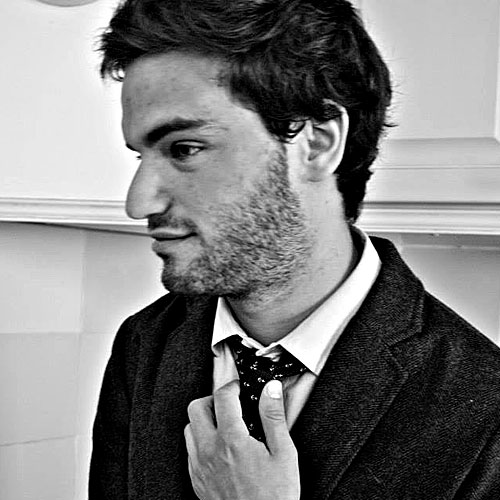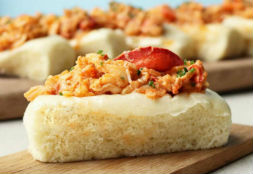The reason for developing the Cicerone Certification Program—essentially, the beer equivalent of the master sommelier test—was quite simple: too much shitty beer.
“I realized there was a lot of bad beer being served,” says its founder Ray Daniels, in the new documentary Beers of Joy. “Bars and restaurants didn’t know how to take care of the beer, and certainly servers didn’t know anything about the beer.”
Though the program has four certification tiers, since its inception in 2007, only 18 people have passed the Master Cicerone exam—a grueling, two-day, 20-hour test comprised of extensive written and oral assessments, as well as blind tastings, with a pass rate of under 10%.
One of those 18 people is Ryan Daley, who, for the last several years, has served as a Senior Beer Educator for Anheuser-Busch. His job entails going around the country and training retailers, wholesalers and salespeople on the basic aspects of beer—the ingredients, brewing processes, styles and flavor profiles—to help get the right beer into drinkers' hands. If this sounds like a pretty sweet gig, for which one gets to drink a lot of beer, well...yes, both those things are true.
But all of that in-depth beer-related knowledge didn’t come easy. To become a Master Cicerone, it took Daley (pictured above) about two years of intensive study. His trials were documented in Beers of Joy, which tracks the journeys of four crazy beer enthusiasts, including a home-brewing obsessive and a brewer dedicated to making the perfect Berliner Weisse. It’s available now to rent on iTunes. (Full disclosure: Anheuser-Busch co-produced and helped finance the film.)
Prior to the release, I spoke with Daley about how he became a Master Cicerone, where the industry is heading and the beer he's been drinking lately.
Who tends to go for the Master Cicerone Certification? And why have so few people passed?
In terms of who actually makes up that group of 18 people, it’s a few people who work directly for the Cicerone program, a few people who work for breweries, either in a brewing capacity or an education capacity, and there are a few people who are more of consultants.
The Cicerone program as a whole was created in 2007. It’s a 20-hour test over two days, and the pass rate is generally less than 10%. So although they’re only having so many people come through on an annual basis, very few if any are able to pass. And the time and commitment it takes is quite intense, so it’s not really something you want to just dip your toe into, either.
How did you go about studying for the exam?
Essentially, the Cicerone program covers five general areas: the service of beer; the flavor and evaluation of beers, being very strong from a sensory perspective; being very knowledgeable on beer styles; being knowledgeable on ingredients and process; and ultimately pairing beer and food. So that’s kind of the universe of what I was studying.
In terms of my overall approach, I’m going to say it was about 2 years' worth of study. I really kind of started when I studied for the Advance [certification, which comes before Master]. Early on, it was a ton of reading, dozens and dozens of books, to get through as much information as I could. But at that time you’re not necessarily retaining—or I personally wasn’t retaining a ton of information. So then I would go back through all of those books. Everything I went through and highlighted I would then write out in hand in binders, [arranged] kind of by topics. That took months. But it was good because it helped me retain some of that information and it really just helped me package it up in a way where, once I had, I’ll say, 15 really thick binders, then I really just started going through them quite frequently.
Throughout that, I’m sprinkling in some other trainings with some different organizations, and doing a lot of tasting—that’s a big part of the exam.
Do they tell you what to study?
There’s a syllabus for the exam—really a syllabus for all four levels. And then recommended resources for each level. They don’t have you going in blind.
What’s the breakdown of the test?
The Master exam is administered over the course of two full days. Each day you do a written portion, which is about three hours of writing essays. There’s a portion around oral exams, which is another three hours or so. And then there are four different tasting exams.
Then you rinse and repeat and kind of do it all over [the next day].
What’s an example of something you might find on the written exam and the oral exam?
An essay could be, ‘Here’s three styles of beer from Germany, talk about what sort of ingredients are used, anything unique in the brewing process, the overall flavor profiles, specific stats around alcohol and color and bitterness, commercial examples, specific flavor profiles for those commercial examples, comparing and contrasting those beer styles...'
In terms of an oral exam, you could walk into the room, and, say it’s something on food and beer, there might be someone on the other side of the table, who has cheese or a plate of food or a certain dish and you have to taste it and talk about the flavors you’re experiencing. Then they may have a selection of beers on the table and you have to talk about those, taste some of those, describe the flavors you’re experiencing, then start to say which beer you would pair with that food, why you would you do that, how the beer is going to improve the food and vice versa. Each oral exam is between 10 and 15 minutes.
And the blind taste test?
There are eight different tasting exams, and each one is 15 minutes long. They test you in a few different ways. A few of those tasting exams are specific to identifying certain flavors, so you would essentially have eight to 10 blind samples, and you have to go through and identify the key flavor in each, using a control beer as a reference. One of them is around style and identification, so they give you seven blind beers and you need to taste and evaluate each and identify what style of beer it is [Ed. Note: There are around 100 styles, and the program developed 350 flavors to help identify them]. Some of the [tastings] are around technical analysis. So you may get four beers and you essentially have to taste, evaluate and write a full technical analysis that comments on the overall profile of the beer, anything from appearance, to aroma, to taste, to mouth feel, to specific flavor compounds you’re identifying.
[Ed. Note: In the film, watching Daley blind taste test beers is a sight to behold. Imagine the automatic stream of technical jargon an ER doctor spouts while diagnosing a patient, if the doctor was a t-shirt wearing dad and the patient was a tasty Belgian trippel or whatever.]
How much beer are you drinking to study for this thing?
A decent amount. When you taste, you don’t really need to drink a ton of beer. You can get a lot based on just aroma and you don’t really need to take a ton of sips or big sips to dive deep into a beer. So even if I’m doing a full day of tasting training, where I might taste 50 or 60 different samples, at the end of the day it probably only equates to a handful of beers. Which over the course of the day is really not that much.
As an expert, do you have any tips on pairing beer with food?
I’d say very succinctly, for the average person, just try to align the intensity, try to find some flavor interaction between the two, and then think about how you can select a beer that has some good cutting, some good contrast, that really keeps your palette fresh.
Any pairings in particular you might recommend?
I think a really fun place to play around is cheese, just because you don’t need a ton of it, you can get a few different varieties and you can kind of pick and play around with a few different beers.
Are there any significant trends you’re noticing in beer right now?
In certain ways, we’ve been living in an IPA world for the last few years. That continues to be a place where people are exploring, and a trend that isn’t stopping, at least in the short term.
It seems like the sour beers are becoming more and more acceptable, at least in the U.S. And it seems like a lot of breweries are playing around with different types of sour beers, whether it be something like a Gose or a Berliner Weisse or something that’s barrel-aged.
And I think in general, you’re seeing trends towards more sessionability. You go back a few years, where everything was all 12% ABV and 80 IBUs, and now people are coming back to a space where they want a beer that’s a little more sessionable, a little lower alcohol, not as bitter, something that they can sit down and enjoy a few of.
What have you been drinking lately?
I drink it all. One style I’ve continued to become a bigger and bigger fan of is a Douze, which is a Belgian style. It’s a blend of vintage Lambic beers.
If you’re going to take a beer and a shot, though, what’s your combo?
[Laughs] Could be a Bud and a whiskey.
This conversation has been lightly edited and condensed for clarity.






